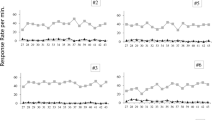Abstract
In his effort to distinguish operant from respondent conditioning, Skinner stressed the lack of an eliciting stimulus and rejected the prevailing stereotype of Pavlovian “stimulus-response” psychology. But control by antecedent stimuli, whether classified as conditional or discriminative, is ubiquitous in the natural setting. With both respondent and operant behavior, symmetrical gradients of generalization along unrelated dimensions may be obtained following differential reinforcement in the presence and the absence of the stimulus. The slopes of these gradients serve as measures of stimulus control, and they can be steepened without applying differential reinforcement to any two points along the test dimension. Increases and decreases in stimulus control occur under the same conditions as those leading to increases and decreases in observing responses, indicating that it is the increasing frequency and duration of observation (and perhaps also of attention) that produces the separation in performances during discrimination learning.
Similar content being viewed by others
References
Buchwald, A. M. (1969). Effects of “right” and “wrong” on subsequent behavior: A new interpretation. Psychological Review, 76, 132–143.
Dinsmoor, J. A. (1951). The effect of periodic reinforcement of bar-pressing in the presence of a discriminative stimulus. Journal of Comparative and Physiological Psychology, 44, 354–361.
Dinsmoor, J. A. (1952). The effect of hunger on discriminated responding. Journal of Abnormal and Social Psychology, 47, 67–72.
Dinsmoor, J. A. (1983). Observing and conditioned reinforcement. Behavioral and Brain Sciences, 6, 693–704.
Dinsmoor, J. A. (1985). The role of observing and attention in establishing stimulus control. Journal of the Experimental Analysis of Behavior, 43, 365–381.
Dinsmoor, J. A., Flint, G. A., Smith, R. F., & Viemeister, N. F. (1969). Differential reinforcing effects of stimuli associated with the presence or absence of a schedule of punishment. In D. P. Hendry (Ed.), Conditioned reinforcement (pp. 357–384). Homewood, IL: Dorsey.
Dinsmoor, J. A., Thiels, E., Lee, D. M., Pfister, J., & Dougan, J. D. (1989). Selective observing: Pigeons turn discriminative stimuli on and off by pecking separate keys. In N. W. Bond & D. A. T. Siddle (Eds.), Proceedings, XXIVth International Congress of Psychology: Vol. 6. Psychobiology: Issues and applications (pp. 443–456). Amsterdam: Elsevier.
Fantino, E. (1977). Conditioned reinforcement: Choice and information. In W. K. Honig & J. R. Staddon (Eds.), Handbook of operant behavior (pp. 313–339). Englewood Cliffs, NJ: Prentice-Hall.
Farthing, G. W., & Hearst, E. (1968). Generalization gradients of inhibition after different amounts of training. Journal of the Experimental Analysis of Behavior, 11, 743–752.
Guttman, N., & Kalish, H. I. (1956). Discriminability and stimulus generalization. Journal of Experimental Psychology, 51, 79–88.
Hearst, E. (1968). Discrimination learning as the summation of excitation and inhibition. Science, 162, 1303–1306.
Hearst, E. (1969). Excitation, inhibition and discrimination learning. In N. J. Mackintosh & W. K. Honig (Eds.), Fundamental issues in associative learning (pp. 1–41). Halifax, Nova Scotia: Dalhousie University Press.
Hearst, E. (1975). The classical-instrumental distinction: Reflexes, voluntary behavior, and categories of associative learning. In W. K. Estes (Ed.), Handbook of learning and cognitive processes: Vol. 2. Conditioning and behavior theory (pp. 181–223). Hillsdale, NJ: Erlbaum.
Hearst, E., & Koresko, M. B. (1968). Stimulus generalization and amount of prior training on variable-interval reinforcement. Journal of Comparative and Physiological Psychology, 66, 133–138.
Honig, W. K. (1966). The role of discrimination training in the generalization of punishment. Journal of the Experimental Analysis of Behavior, 9, 377–384.
Jenkins, H. M., & Harrison, R. H. (1960). Effects of discrimination training on auditory generalization. Journal of Experimental Psychology, 59, 246–253.
Keller, F. S. (1943). Studies in international Morse code: I. A new method of teaching code reception. Journal of Applied Psychology, 27, 407–415.
Keller, F. S., & Schoenfeld, W. N. (1950). Principles of psychology. New York: Appleton-Century-Crofts.
Lyons, J., & Thomas, D. R. (1967). Effects of interdimensional training on stimulus generalization: II. Within-subject design. Journal of Experimental Psychology, 75, 572–574.
Marsh, G. (1972). Prediction of the peak shift in pigeons from gradients of excitation and inhibition. Journal of Comparative and Physiological Psychology, 81, 262–266.
Millenson, J. R., & Dent, J. G. (1971). Habituation of conditioned suppression. Quarterly Journal of Experimental Psychology, 23, 126–134.
Pavlov, I. P. (1960). Conditioned reflexes: An investigation of the physiological activity of the cerebral cortex (G. V. Anrep, Trans.). New York: Dover. (Original work published 1927)
Rescorla, R. A. (1988). Pavlovian conditioning: It’s not what you think it is. American Psychologist, 43, 151–160.
Skinner, B. F. (1933). The rate of establishment of a discrimination. Journal of General Psychology, 9, 302–350.
Skinner, B. F. (1937). Two types of conditioned reflex: A reply to Konorski and Miller. Journal of General Psychology, 16, 272–279.
Skinner, B. F. (1938). The behavior of organisms: An experimental analysis. New York: Appleton-Century-Crofts.
Skinner, B. F. (1972). Cumulative record: A selection of papers (3rd ed.). New York: Appleton-Century-Crofts.
Spence, K. W. (1936). The nature of discrimination learning in animals. Psychological Review, 43, 427–449.
Sutherland, N. S., & Mackintosh, N. J. (1971). Mechanisms of animal discrimination learning. New York: Academic Press.
Terrace, H. S. (1963). Discrimination learning with and without “errors.” Journal of the Experimental Analysis of Behavior, 6, 1–27.
Weisman, R. G., & Palmer, J. A. (1969). Factors influencing inhibitory stimulus control: Discrimination training and prior non-differential reinforcement. Journal of the Experimental Analysis of Behavior, 12, 229–237.
Wyckoff, L. B. (1952). The role of observing responses in discrimination learning. Part 1. Psychological Review, 66, 68–78.
Wyckoff, L. B. (1969). The role of observing responses in discrimination learning. In D. P. Hendry (Ed.), Conditioned reinforcement (pp. 237–250). Homewood, IL: Dorsey.
Author information
Authors and Affiliations
Rights and permissions
About this article
Cite this article
Dinsmoor, J.A. Stimulus Control: Part I. BEHAV ANALYST 18, 51–68 (1995). https://doi.org/10.1007/BF03392691
Published:
Issue Date:
DOI: https://doi.org/10.1007/BF03392691




